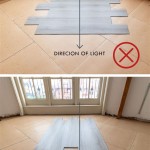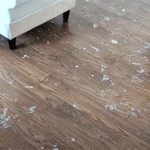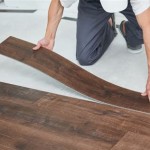How to Effortlessly Install Vinyl Plank Flooring Over Ceramic Tiles
Transforming your flooring with vinyl plank over ceramic tiles is a savvy renovation that blends style and functionality. With careful preparation and the right tools, you can achieve a seamless and professional-looking finish.
Step 1: Preparing the Existing Surface
Begin by thoroughly cleaning and drying the ceramic tiles to remove any dirt, grease, or adhesive residue. Using a leveling compound, fill any uneven areas or cracks to create a smooth and level surface. Allow ample time for the compound to dry and cure.
Step 2: Installing an Underlayment
An underlayment provides cushioning and insulation beneath the vinyl planks. Select an underlayment specifically designed for vinyl plank flooring and cut it to fit the area. Ensure it is laid flat and secure, following the manufacturer's instructions.
Step 3: Planning the Plank Layout
Start by determining the direction in which you want to install the planks. Typically, running them parallel to the longest wall creates an illusion of space. Measure and mark the starting point and any necessary cuts.
Step 4: Applying Adhesive
Use a notched trowel to apply even coats of adhesive onto the surface. Work in small sections to prevent the adhesive from drying prematurely. Ensure the adhesive is spread thoroughly and avoid creating air pockets.
Step 5: Installing the Vinyl Planks
Carefully align the first plank with the starting point and press it firmly into the adhesive. Continue installing the planks in staggered rows, ensuring they fit snugly together. Use a tapping block and hammer to secure the edges and eliminate gaps.
Step 6: Cutting and Trimming
For irregular areas, you'll need to cut the planks to fit. Use a utility knife and a straight edge to mark and cut the necessary shapes. Where the planks meet walls or obstacles, measure and trim them to form tight fits.
Step 7: Finishing Touches
Once the entire floor is covered, apply base molding or quarter round to conceal expansion gaps and create a polished finish. Additionally, install transition strips at doorways or areas where the flooring meets other surfaces.
Tips and Considerations
- Use a razor blade to remove excess adhesive that may squeeze out during installation.
- Allow at least 24 hours for the adhesive to cure before exposing the floor to heavy traffic.
- Stagger the seams of consecutive rows to avoid a repetitive pattern.
- Install vinyl planks designed for floating floors if you prefer a less permanent solution.
- Consider professional installation if you lack experience or have a large area to cover.

How To Install Luxury Vinyl Plank Over Tile Flooring

New Vinyl Plank Flooring Over Tile Table And Hearth

Transform Your Home Installing Vinyl Flooring Over Ceramic Tiles City Wall And Floor

How To Install Vinyl Plank Floors In A Bathroom Over Tile

How To Install Vinyl Plank Floors In A Bathroom Over Tile

New Vinyl Plank Flooring Over Tile Table And Hearth

Vinyl Plank Wood Directly Over Tile

Can You Put Vinyl Plank Flooring Over Ceramic Tile Nadine Floors

How To Install Vinyl Plank Flooring In A Bathroom Fixthisbuildthat

What Type Of Flooring Can You Install Over Ceramic Tile
See Also







